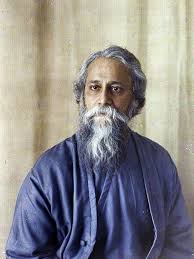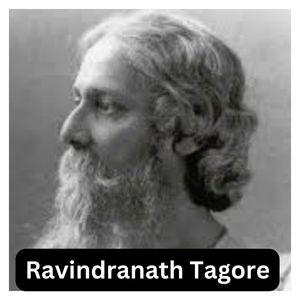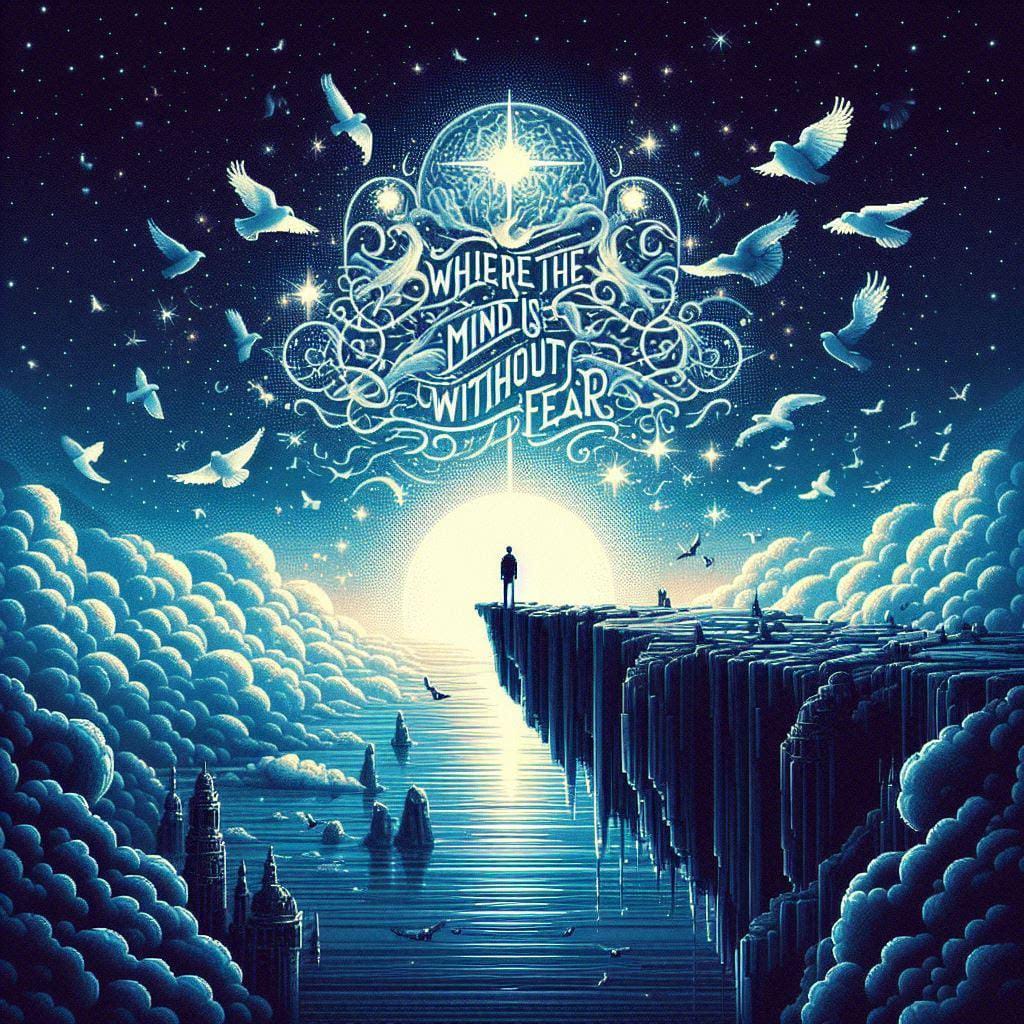In this post, notes of Unit 2 (Reading Poetry – Rabindranath Tagore: ‘Where the Mind is Without Fear’) from DSC – 1 (Introduction to Literary Studies) are given which is helpful for the students doing graduation this year.
Rabindranath Tagore: ‘Where the Mind is Without Fear’
Rabindranath tagore information

Rabindranath Tagore (1861-1941) was a talented person who wrote poems, thought deeply about life, made music, and was the first non-European to win the Nobel Prize in Literature in 1913.
He was born in Calcutta (now Kolkata), India, into a well-known Bengali family. Tagore was very important in the cultural and educational growth of Bengal in the late 1800s and early 1900s.
He helped in many areas, including writing, music, art, education, and social change.
Literary Contributions of Rabindranath Tagore:
| Category | Details |
|---|---|
| Poetry | Tagore’s poetry, including Gitanjali (Song Offerings), delves into themes like spirituality, nature, love, and the divine. It is considered world-class. |
| Prose | His notable prose works include novels such as The Home and the World (Ghare-Baire) and Gora. These works explore societal issues and human psychology. |
| Music | A skilled composer, Tagore created Rabindra Sangeet, a significant contribution to Bengali culture, known for its melody and meaningful lyrics. |
| Painting | Tagore was also an accomplished painter, influencing modern Indian art through his experimental and philosophical approach. |
Educational Philosophy of rabindranath tagore:
Visva-Bharati: In 1901, Tagore started Visva-Bharati University in Santiniketan. It wanted to combine the best ideas from Indian and Western education. It became a place for art, culture, and sharing knowledge.
Social and Political Views:
Humanism: Tagore believed in the value of personal freedom, accepting others, and bringing people together.
His writings often shared a message that went beyond different cultures and countries.
Nationalism: At first, Tagore supported India’s fight for independence, but later he criticized narrow nationalism.
He was against the ways nationalism can divide people and worried about the risks of only focusing on national identity.

History of rabindranath tagore:
Late 19th to early 20th Century Bengal Renaissance: Tagore became well-known during the Bengal Renaissance, a time when art, literature, and social changes were growing in Bengal. Thinkers like Tagore were very important during this period.
British Colonial Rule: Tagore lived when Britain ruled India. What he saw and experienced in society and politics shaped his writing, and he spoke out against unfair colonial rules.
Cultural Exchange: Tagore connected with people around the world and talked with Western thinkers. He traveled a lot to share ideas between Eastern and Western cultures.
Rabindranath Tagore’s influence went beyond his life, and his work still affects literature, music, education, and social ideas in India and worldwide.
| Related | |
|---|---|
| Short Summary of Tara by Mahesh Dattani | Composed Upon Westminster Bridge By William Wordsworth Summary |
Where the Mind is Without Fear Summary and analysis

“Where the Mind is Without Fear” is a powerful poem by Rabindranath Tagore, written in Bengali, and is part of his book “Gitanjali”, which won him the Nobel Prize in Literature in 1913.
The poem is seen as a wish for freedom, togetherness, and understanding for India and all people.
It shows Tagore’s hope for a society that is brave, honest, and peaceful, reflecting his dreams for his country during British rule. Here is a simple summary of the poem, line by line:
Where the Mind is Without Fear sammary:
line 1: "Where the mind is without fear and the head is held high"

Tagore imagines a place where people are not afraid and feel proud. He wants a society where everyone has self-respect and confidence, without any shame or oppression.
Line 2: "Where knowledge is free"

Tagore wants everyone to have access to knowledge. He dreams of a place where education is open to all, without barriers due to social status or money, so that everyone can learn and grow.
Line 3: "Where the world is not divided into pieces by small, personal barriers"

- Here, Tagore expresses sadness about the divisions caused by caste, class, religion, and other personal barriers.
He imagines a world without divisions, where people are not separated by social and political differences but come together as one.
Line 4: "Where words come from the heart of truth"

Tagore supports being honest and sincere when we speak. He hopes for a society where people only say what is true, using words that reflect their true feelings, without fear of punishment or judgment.
Line 5: "Where hard work reaches for perfection"

This line shows Tagore's belief in working hard and being determined. He imagines a world where people always try their best to improve themselves and help others, always aiming for self-improvement and perfection.
line 6: "Where the clear stream of reason has not lost its way into the dreary desert sand of dead habit"
Tagore uses the image of a "clear stream" to show reason and logic. He wants a society where clear thinking is not blocked by old beliefs and outdated customs.
He warns that following habits without question can lead to a dull and lifeless place that stops growth and understanding.
line 7: "Where the mind is led forward by thee into ever-widening thought and action"
Tagore hopes for a better society where people are always inspired to think more and do more.
He believes this is guided by a higher power that helps humanity grow and reach new ideas.
line 8: "Into that heaven of freedom, my Father, let my country awake"
In the last line, Tagore speaks to a higher power, asking for his country and the world to wake up to true freedom.
This freedom includes not just political rights but also freedom of thought, spirit, and culture—freedom from all kinds of unfairness and closed-mindedness.
| Related | |
|---|---|
| Narratology Form and Function of Narrative summary | A.N. Kaul’s essay “A New Province of Writing” notes |
Short Summary of Poem "where the mind is without fear"
The poem imagines a perfect world where people are not afraid and can grow mentally and spiritually.
Tagore shares his hope for a nation that is open-minded and forward-thinking, free from narrow views and unfair treatment.
In the poem, Tagore talks about a country where people can be proud and confident. He dreams of a place where learning is not restricted and where everyone can seek knowledge and truth without fear.
The poet wants a society where reason and awareness are important, helping both individuals and communities to grow.
The main theme is about wanting a free mind that can explore and learn without limits. Tagore's vision is not just about personal freedom but also about a society that values truth and understanding.

critically analyse the poem where the mind is without fear:
Freedom and Fearlessness: The poem begins with the speaker wanting a country "Where the mind is without fear and the head is held high." This means that mental freedom and being unafraid are important for people and the country to improve.
Knowledge and Enlightenment: Tagore stresses how important knowledge is in the poem. He imagines a world where people can find the truth freely, think clearly, and learn without fear of punishment or control.
Ideas for a Better Nation: The poet dreams of a country that is modern, aware, and forward-looking. He wants a society that seeks truth and knowledge, free from ignorance and prejudice.
Call for Action: Tagore's poem is not just a dream; it urges action. He asks God to help the nation become brave, showing that everyone needs to work for this change.
Critique of Current State: The poem also criticizes the current social and political situation. Tagore imagines a better future than what exists now, showing his unhappiness with the lack of freedom and knowledge in his time.
"Where the Mind is Without Fear" is a powerful poem that connects with readers because of its themes of freedom, knowledge, and growth.
Tagore's vision still inspires people and reminds us how important it is to create an environment that encourages learning and courage.
Theme and message of ‘Where the Mind is Without Fear’
Central theme of the poem where the mind is without fear :
The main theme of the poem "Where the Mind is Without Fear" is about the poet's dream for a perfect society. Tagore wants a world where people are free from fear, which helps them grow in knowledge and spirit. The poem includes several key theme:
1. Freedom and Fearlessness: The main theme is about wanting freedom and being without fear. Tagore imagines a society where people can think, ask questions, and share their thoughts without being scared of punishment.
This shows how much he values personal freedom and believes that being fearless is important for everyone to grow.
2. Intellectual Growth: The poem highlights the need for learning and understanding. Tagore dreams of a nation where minds can search for truth and reason without being held back by ignorance. This shows his belief that knowledge and education can change lives.
3. Progress and Idealism: Tagore's vision is hopeful and positive. He sees a nation that is moving forward and aiming for a better future. The poem expresses a wish for good changes, where society values truth, reason, and working together for progress.
4. Spiritual Appeal: The poem also has a spiritual side, as Tagore speaks to a higher power. He believes that seeking help from the divine can lead the nation to a place of fearlessness and understanding.
What is the message of the poem where the mind is without fear?
The poem "Where the Mind is Without Fear" has many important massages that are relevant to everyone. Here are some main points:
Freedom for Individuals and Nations: The poem calls for people to be free from fear and limitations. It also wishes for a country that is free, brave, and knowledgeable.
The Importance of Knowledge: Tagore highlights how knowledge and reason are important for personal and social growth. He dreams of a society where people can seek truth and learn without barriers.
Hope for Change: The poem has a hopeful message, indicating that positive change is possible. Even though there is fear and restrictions now, Tagore encourages people and the country to work towards a better and brighter future.
Spiritual Aspect: The mention of a higher power adds a spiritual layer to the poem. It suggests that the quest for freedom and knowledge is connected to something greater. This spiritual side shows the complete nature of Tagore's vision.
In summary, "Where the Mind is Without Fear" is a call for a society that values freedom, courage, knowledge, and progress. Tagore's message inspires people to reach for better goals and to help create a world where minds are free from fear.
Form and structure of ‘Where the Mind is Without Fear’
The form and structure of Rabindranath Tagore's poem "Where the Mind is Without Fear" contribute to the overall impact and effectiveness of the work. Here are the details of the form and structure:
Form of ‘Where the Mind is Without Fear’:
Free Verse: The poem is written in free verse, meaning it does not have a set rhyme or rhythm. This lets Tagore share his ideas freely without following strict poetic rules. Free verse often feels more natural and flowing.
Prose-Like Style: Tagore's language in this poem is like prose, with sentences smoothly connecting. This style makes the poem feel more casual and thoughtful, allowing many people to understand it easily.
Structure of ‘Where the Mind is Without Fear’:
- Stanzas: The poem has one stanza, making it a monostich poem. This choice gives it a sense of unity. Even though it's short, it has strong themes.
- Line Length: The poem does not follow a strict rhythm, but the lines are all about the same length. This keeps each thought clear and focused.
- Repetition: Tagore uses the phrase "Where the mind is without fear" at the start of each line to emphasize the main theme of the poem. This makes it feel rhythmic, even without a rhyme scheme.
- Enjambment: The poem uses enjambment, meaning that thoughts flow from one line to the next without stopping. This creates a smooth flow, connecting themes easily.
- Imagery and Symbolism: The poem is rich in images and symbols. Tagore uses strong language to show the ideal world he imagines, making the poem emotionally powerful.
In summary, "Where the Mind is Without Fear" is a free verse poem with one stanza, short lines, repetition, enjambment, and a straightforward style.
Tagore's choices make the poem easy to understand and impactful, letting readers connect with its themes about freedom and fearlessness.
Poetic Devices in Where the mind is without fear
Rabindranath Tagore's poem "Where the Mind is Without Fear" employs various literary devices and a distinct language style to convey its profound message. Here are the details of the literary devices and language used in the poem:
Alliteration:
Examples: "mind is without fear," "knowledge is free," "narrow domestic walls."
Alliteration is the repetition of consonant sounds at the beginning of adjacent or closely connected words. In this poem, it adds a rhythmic quality to the lines and emphasizes key concepts.
Repetition:
Examples: The repeated phrase "Where the mind is without fear" at the beginning of each line serves as a refrain, reinforcing the central theme and creating a rhythmic structure. This repetition is a powerful rhetorical device that underscores the poet's vision.
Metaphor:
Example: "Into that heaven of freedom, my Father, let my country awake."
The use of "heaven of freedom" is a metaphorical expression for the poet's vision of an ideal, liberated society. It conveys a sense of utopia and heightened enlightenment.
Imagery:
Example: "Where the clear stream of reason has not lost its way."
The use of imagery creates vivid mental pictures. Here, the "clear stream of reason" conjures an image of unobstructed, transparent thought, emphasizing the importance of rationality.
Symbolism:
Example: "Into that heaven of freedom."
The term "heaven" symbolizes the ideal state of freedom and enlightenment that the poet envisions. It represents a transcendent, utopian realm that contrasts with the limitations of the present.
Parallelism:
Example: "Where the mind is led forward by thee / Into ever-widening thought and action."
The use of parallelism involves the repetition of similar grammatical structures. It adds a rhythmic and balanced quality to the lines, reinforcing the forward movement of the mind.
Enjambment:
Example: "Where the mind is without fear and the head is held high / Where knowledge is free."
Enjambment is the continuation of a sentence or clause without a pause beyond the end of a line. It contributes to the flowing and uninterrupted quality of the poem.
Anaphora:
Example: The repetition of the phrase "Where the mind is without fear" at the beginning of each line creates an anaphoric structure. It emphasizes the poet's vision and anchors the reader's attention to the central theme.
Language Style:
Tagore's language style in this poem is characterized by simplicity, clarity, and a profound depth of thought. The language is accessible yet rich in imagery and symbolism, making the poem widely relatable while conveying complex ideas about freedom, enlightenment, and societal progress.
In conclusion, "Where the Mind is Without Fear" showcases Tagore's mastery of literary devices such as alliteration, repetition, metaphor, imagery, symbolism, parallelism, and anaphora.
These devices enhance the poetic and rhetorical impact of the poem, contributing to its enduring appeal and universal resonance.
What is the central idea of Where the Mind is Without Fear?

The main idea of *"Where the Mind is Without Fear"* by Rabindranath Tagore is the poet's hope for a free and united country. Tagore imagines a world where people are not afraid, value truth, seek knowledge, and are free from small differences. He dreams of a society that is based on reason, respect, and forward-thinking, striving for freedom and togetherness.
What kind of fear is the poet talking about Where the Mind is Without Fear?

In "Where the Mind is Without Fear," the poet Rabindranath Tagore talks about how oppression, ignorance, and limits on freedom create fear. This fear stops people from thinking for themselves, speaking honestly, and learning freely. It holds back the mind and spirit, making it hard for society to grow and come together.
What is the significance of the title Where the Mind is Without Fear?

The title *"Where the Mind is Without Fear"* means a place where people are free and brave. Here, they can think, talk, and act without being scared of control or limits. It shows the poet's wish for a free society, where everyone can seek truth, knowledge, and express themselves, leading to progress and togetherness.
Where the Mind is Without Fear conclusion?

The title *"Where the Mind is Without Fear"* means a place where people are free and brave. Here, they can think, talk, and act without being scared of control or limits. It shows the poet's wish for a free society, where everyone can seek truth, knowledge, and express themselves, leading to progress and togetherness.
Click Here for Full text of Poem: Where the mind is without fear and the head is



